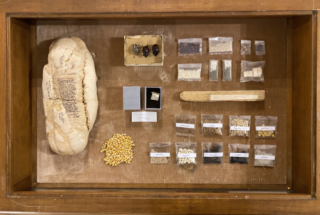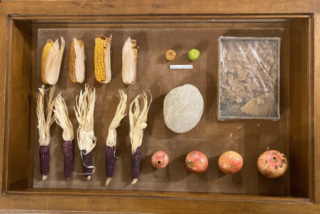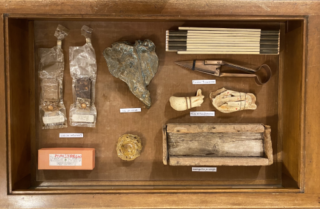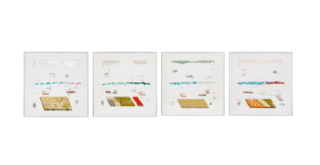
Agricola Cornelia 1 1973
mixed media
Courtesy of the Artist and Fondazione Baruchello

Agricola Cornelia 2 1973
mixed media
Courtesy of the artist and Fondazione Baruchello

Agricola Cornelia 3 1973
mixed media
Courtesy of the artist and Fondazione Baruchello

Agricola Cornelia. Questio de aqua et terra (A) 1980
industrial enamels, ink on aluminum
Agricola Cornelia. Questio de aqua et terra (B) 1980
industrial enamels, ink on aluminum
Agricola Cornelia. Questio de aqua et terra (C) 1980
industrial enamels, ink on aluminum
Agricola Cornelia. Questio de aqua et terra (D) 1980
industrial enamels, ink on aluminum
Courtesy of the artist and Fondazione Baruchello
Gianfranco Baruchello’s pioneering conceptual approach is foundational to Italian art history of the 20th and 21st centuries, deconstructing and reconfiguring contemporary systems of signification. The constellation of works presented in ‘Rethinking Nature’ stem from ‘Agricola Cornelia Società per Azioni’, a project undertook by the artist between 1973 and 1981, when he occupied a plot of land in the outskirts of Rome in order to cultivate it. By rescuing this terrain from real estate speculation and employing it to grow vegetables and tend cattle, the artist questioned the limits of art at a time in which practices such as Land Art were defining the possibilities of artistic interaction with the natural environment. Baruchello’s pioneering focus on agriculture as knowledge-development and his rethinking of farming as a creative activity led to a series of experimentations documented here by historical photographs presented alongside three vitrines whose contents are structured as notes for the yet-to-come on notions of nourishment, politics, and human-animal relations. What started as a project of political militancy soon turned into an exploration of the relations between the actions performed in the agricultural context and the artist’s imaginary relating to nature. In the series Agricola Cornelia. Questio de aqua et terra he articulates through his peculiar calligraphic and diaristic style the relations among the multiple layers of the land and those of his psyche. Such relation with agriculture, considered not as mere productive activity but as a practice that invests one’s whole being and sensibility, is further articulated in the drawings Progetto Kanak. Inspired by the holistic understanding of agriculture of Kanak culture in New Caledonia, the diagrams intertwine multiple levels of reality, knowledge, and speculation on a new political understanding of agriculture. Costruire una torre al mattino con materiali trovati, a series of sculptures developed through the daily exercise of collecting discarded materials, combines individual sensibility and radical imagination to envision new forms of living.
Excerpt from Gianfranco Baruchello, ‘How to Imagine: A Narrative on Art and Agriculture’ (1983)
‘Agricola Cornelia and all of the agricultural operations that have been performed here are themselves something imaginary. The animals we’ve raised and the cultivations we’ve grown have been both real and mythical at one and the same time. They’ve assumed a value as analogs and seem to have been inventions that were in some way or another alchemical. The cultivations of the fields were finally made without any real purpose, or rather with the single purpose of turning us into adepts of cultivation. You couldn’t say that this was our original intent, but our intentions and our discovered purposes prove to be two different things. You decide that this field is to be cultivated because it’s a source of food and can satisfy that kind of primary necessity, and later you come to realize that the most important thing of all has been electing yourself the adept of this field.’